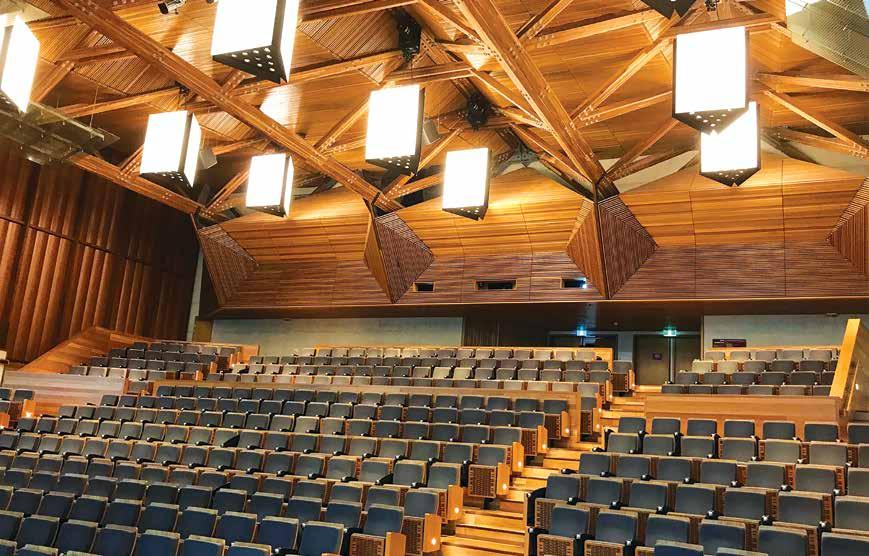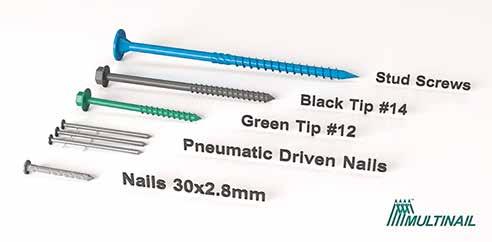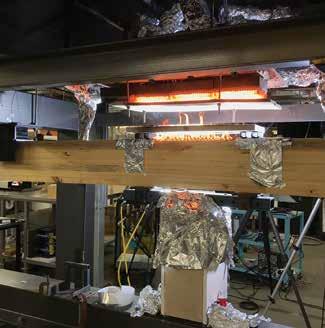
9 minute read
Research
Taking engineered wood to the top
•The interior of the main lecture theatre at the University of Queensland’s Advanced Engineering Building.
PHILIP HOPKINS
IT’S appropriate that The University of Queensland’s (UQ) wood research centre, the Centre for Future Timber Structures (CFTS), is located in the Advanced Engineering Building.
The main lecture theatre, made from timber, displays engineered wood in its beauty and functionality as a learning space.
That’s what the CFTS, which includes the ARC Future Timber Hub, is all about – research into engineered wood, with a particular emphasis on the development of tall timber buildings in Australia and the Pacific, said Kelly Rischmiller, manager of the CFTS and Hub, which is funded by the Australian Research Council.
The Hub emphasises collaboration between its partners – UQ, Queensland’s Department of Agriculture and Fisheries (DAF), Arup, Hyne Timber, Lendlease and the Queensland Fire and Emergency Services. Other backers are Griffith University, New Zealand’s forest research centre Scion NZ, the University of British Columbia and the University of Canterbury.
The latter institutions point to the universal spirit of timber research, which is also reflected in many of its researchers at UQ. ‘Australasian Timber’ spoke to three of these – Dr Luis Yerman from Uruguay, and Dr Felix Wiesner and Dr Lisa Ottenhaus, both from Germany. Dr Yerman and Dr Wiesner are part of the National Centre for Timber Durability and Design Life, a collaborative research program between the University of the Sunshine Coast, UQ, and DAF with financial support from Forest and Wood Products Australia.
Dr Yerman, a chemical engineer with a background in materials science and waste management who studied in Barcelona, was always interested in bioprocesses, but eventually gravitated towards wood science.
“The director of the centre used to say, ‘I can speak several languages’ - biology, chemistry, engineering. I’m expected to be the connection between them!” he quipped.
With emphasis on extending the life span of a timber product, Dr Yerman is studying how the different variables, such as exposure to water – this could include ocean water - can affect timber structures.
“Timber connections are in many cases metal. Corrosion will affect the mechanical performance of the connections. We also have fungi and its impact on timber. There is a specifically very Australian aspect – termites. It’s in the (research) queue to start later this year, working with Dr Hassan from the University of the Sunshine Coast,” he said.
An immediate project centres on enhancing the effectiveness and long-term preservation of eucalyptus nitens – very important for Tasmania. Dr Yerman’s recent projects include the effects of decay on the flexural behaviour of solid and composite wood products.
Dr Wiesner, a lecturer in timber engineering, has a focus on the durability of timber, but within that context, his area of expertise is timber’s traditional bugbear: fire. His background is in structural fire engineering and the fire safety of timber structures, specifically engineered timber structures.
“The drive to build more sustainable buildings means more demand for timber. It can only be sustainable if a building lasts for a long time,” he said. “If a building decays after 10 years, or 20 years if a fire destroys it, that is a problem.”
Dr Wiesner’s job is to look at fire performance and fire retardants – “protection measures we can use to help the timber in a fire, and also the interaction regarding durability and fire-retardant treatment”, he said.
For example, a fire retardant could reduce durability, such as salts that can reduce the strength and moisture cycle of timber, or durability treatments that could reduce the fire performance of timber through chemical action, acting as an oxidiser, during and after fire.
“The silver bullet …. is both to improve the fire performance and the durability,” he said. “To treat timber, you utilise chemical treatment. You have to get the treatment into the timber, and it then has to stay there for the lifetime of the timber.”
Dr Wiesner said in a building must be designed so that a fire was constrained in a compartment.
“It’s hard to stop ignition; at some point someone will have a faulty charger. It could light something next to it, and once that grows to a certain size, you get ‘flashover’. Everything in a room that can burn will burn,” he said.
“People who build whole timber buildings need to ensure that the fire will go out, especially in higher buildings where the fire service may not be able to intervene. The ideal system is where once you remove all things that can burn – desks, chairs - the timber self-extinguishes.”
To achieve that depended on a few conditions – the timber species, the thickness of the timber, the adhesive used. “Large timber buildings are made from multiple board glued together, so there is a lot of research going on in that area,” he said.
The fire issue was also relevant for exterior timber such as utility poles and fence posts. It was less a safety issue, more a cost issue for utility companies or private farmers. “You don’t want a small wildfire to take out electricity to a community by taking
Nails vs screws in timber connections
NAILS and screws are the two most common fasteners specified by engineers and used by builders.
When considering the suitable fasteners to use, sometimes we have options and sometimes we don’t. Let’s have a look at some common sizes and types of nails and screws which engineers often specify in the design drawings.
Hand Nails and Gun Nails 30mm x Ø2.8mm Reinforced Head Nail
This type of nail is suitable for Multi Grips, Joist Hangers, metal and plywood bracing, and the like. It has a reinforced head, is easy to carry and can be found in most carpenter bags. However, from an engineering point of view, its capacity is relatively low compared to bigger sizes of nails.
Ø3.05mm Gun Nail
The most common lengths of gun nails in timber frames are 75mm and 100mm. They are pneumatically driven nails with equivalent capacities comparable to Ø2.8mm hand-driven nails. It is ideal for fixing two pieces of timber together without any metal ancillaries, however, it is not recommended for fixing metal connectors to timber members.
It is quite hard to achieve the required end or edge dis-

SIU KONG FOX NSW STRUCTURAL ENGINEER AT MULTINAIL
tance as per design standards of timber structures using these gun nails. Refer to Table 1 for more information regarding the minimum end and edge distance and spacing for nails.
Traditional Screws
Gauge 12 (Ø5.59mm) Screw
These screws are available in 35mm, 65mm and 100mm lengths with a much higher capacity than nails. They are also suitable for timber-totimber connections with metal brackets or steel angles.
Gauge 14 (Ø6.4mm) Screw
These screws are available in 75mm, 100mm, 125mm and 150mm lengths with capacities higher than Gauge 12 Screws. They are commonly used in timber joints where higher forces need to be
Spacing End distance Edge distance
Between nails along grain
Between nails across grain Note: D=Shank diameter of screws Minimum distance For Multinail Ø2.8mm nail 20D 5D 20D 10D 20 x 2.8 = 56mm 5 x 2.8 = 14mm 20 x 2.8 = 56mm 10 x 2.8 = 28mm
transferred. It is also a common screw size for fixing roof battens and purlins.
When designing screw fixing details, minimum end and edge distance and spacing for screws need to be considered as well. Same as nails, Table 2 below listed those critical distances according to AS1720.1
New Generations of Screws
The Stud Screw was introduced to timber framing industry to tie down top and ribbon plates to studs in order to replace traditional stud ties or T-plates. It is installed in the factory of wall frame fabricators, along with a tag attached for inspecting purposes.
Screws can hold two pieces of timber together tighter due to their threaded shafts. They also perform better with moisture changes in timber in long term. Screws can provide great tensile strength however, they don’t have good performance when taking shear. Nails can provide greater shear strength, but they may bend under certain amount of load or pressure.
Nails and screws are both excellent fasteners however, considerations need to be made when selecting which type of fasteners that you are going to use in your design.
Edge and end distance and distance between fasteners. This condition may result in your only option being the use of nails.
Penetration depth. Make sure the fasteners are penetrating deep enough into the second member. For example, screws need to penetrate 7 times of its shank diameter into the connecting member to achieve their full shear capacities.
Timber species. Softwood and hardwood may also have some impact on which type of fasteners you should be using. Fixing fasteners into hardwood requires pre-drilling for screws and sometimes nails.
Continued from page 18
out the line; you want to design it to withstand fires.”
His compatriot, Dr Ottenhaus, also a lecturer in structural engineering, became interested in timber when studying civil engineering in Germany. She ended up doing a PhD in seismic design of timber buildings. “I have always had a focus on connections. My specialty is timber connections,” she said.
Her work at UQ is focussed on three main areas. Together with Dr Yerman, she is exploring factors that can change connection performance, such as moisture content.
Another focus is how seismic conditions can affect fasteners in connections. Under reverse seismic loading, vibrations might end up bending a fastener, such as a nail. “It could corrode, like a rusted paper clip; you bend it back and forth and at some point, it snaps,” she said.
Dr Ottenhaus said new European fasteners being used in treated timber in Australia and New Zealand were encountering chemical corrosion, metal on metal corrosion. “We are doing a project on that,” she said.
“I work together with the UQ School of Architecture on timber projects. We have started to explore modular construction and reversible connections in that context. A lot of these reversible connections do come from Europe. Adapting those systems to Australian construction, especially light timber framing, where we use species that have a higher density than most European species - it gets interesting.”
Dr Ottenhaus said back in the 1970s, the CSIRO was a world leader on research into strength in timber connections and timber species. “We are trying to now transition the Australian timber design system towards the European model. This will be a major aim for me, having a combined standard for NZ and Australia, connected to the codifying community in Europe. We are trying to come up with a more uniform approach, as the world is so connected,” she said.
The UQ CFTS and ARC Future Timber Hub are aiming to ensure timber research in Australia is staying true to its universal outlook.




